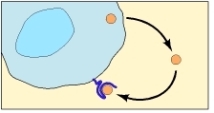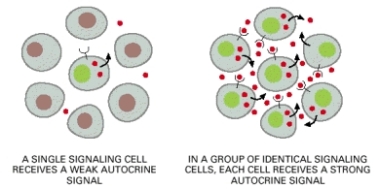Not only do I communicate with my fellow muscle cells but I can communicate with other cells through autocrine signalling, such as nerve cells. This occurs when a cell secretes signal molecules that can bind back to its own receptors. During my development, for example, once I am directed along a particular pathway of differentiation, I can secrete autocrine signals to myself that will reinforce this decision.

Cell producing a signaling molecule to which it responds.
Autocrine signaling is most effective when it is performed simultaneously by neighboring cells of the same type, and it is likely to be used to encourage groups of identical cells to make the same developmental decisions. As a result, the autocrine signaling mechanism is known as the “community effect”. Being that I am in close range to my fellow nerve cell, I am able to respond to a differentiation inducing signal which allows me to actively communicate with it, rather if I were alone and isolated. A group of us cells will produce a higher concentration of a secreted signal than if we were to work alone. When this signal binds back to a receptor on the same cell type, it encourages us, the cells to respond coordinately as a group.
http://www.ncbi.nlm.nih.gov/books/NBK26813/figure/A2751/?report=objectonly
Autocrine signalling.



